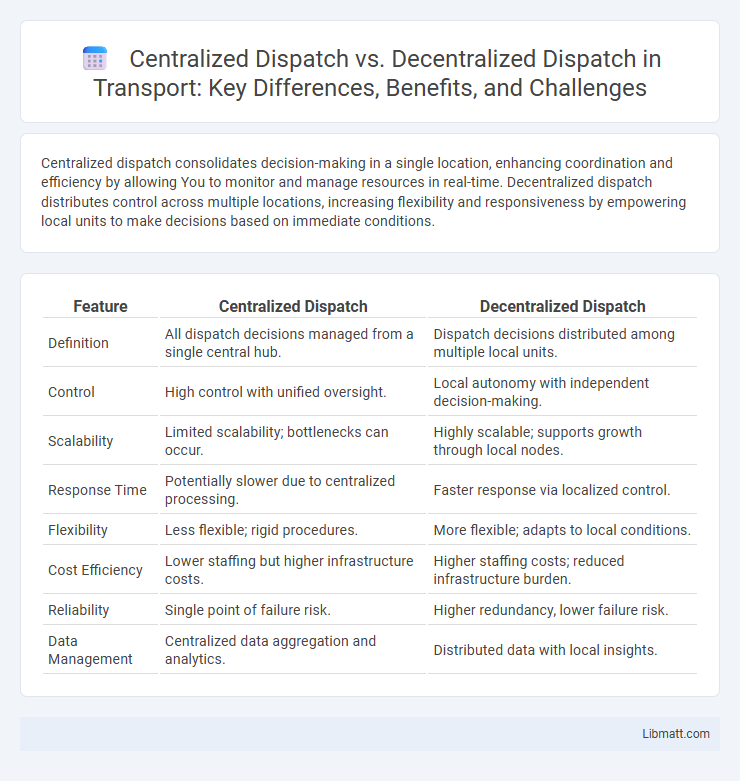Centralized dispatch consolidates decision-making in a single location, enhancing coordination and efficiency by allowing You to monitor and manage resources in real-time. Decentralized dispatch distributes control across multiple locations, increasing flexibility and responsiveness by empowering local units to make decisions based on immediate conditions.
Table of Comparison
| Feature | Centralized Dispatch | Decentralized Dispatch |
|---|---|---|
| Definition | All dispatch decisions managed from a single central hub. | Dispatch decisions distributed among multiple local units. |
| Control | High control with unified oversight. | Local autonomy with independent decision-making. |
| Scalability | Limited scalability; bottlenecks can occur. | Highly scalable; supports growth through local nodes. |
| Response Time | Potentially slower due to centralized processing. | Faster response via localized control. |
| Flexibility | Less flexible; rigid procedures. | More flexible; adapts to local conditions. |
| Cost Efficiency | Lower staffing but higher infrastructure costs. | Higher staffing costs; reduced infrastructure burden. |
| Reliability | Single point of failure risk. | Higher redundancy, lower failure risk. |
| Data Management | Centralized data aggregation and analytics. | Distributed data with local insights. |
Overview of Centralized and Decentralized Dispatch
Centralized dispatch consolidates control in a single location, improving coordination and efficiency by managing all operations through a unified system. Decentralized dispatch distributes decision-making across multiple locations, allowing for greater flexibility and quicker responses tailored to local conditions. Your choice between these methods influences operational agility, resource allocation, and overall system reliability.
Defining Centralized Dispatch Systems
Centralized dispatch systems consolidate control and decision-making processes into a single, centralized unit, enabling real-time coordination and efficient resource allocation across multiple locations. These systems utilize advanced software platforms to monitor, schedule, and deploy workforce or assets, improving response times and reducing operational redundancies. Centralized dispatch enhances visibility and accountability, providing comprehensive data analytics and reporting for optimizing overall service delivery.
Understanding Decentralized Dispatch Operations
Decentralized dispatch operations distribute decision-making authority across multiple locations, enhancing responsiveness and flexibility in complex or large-scale networks. This approach reduces bottlenecks common in centralized dispatch by allowing local units to manage resources and respond to real-time conditions independently. Key benefits include improved scalability, faster problem resolution, and increased operational resilience in dynamic environments such as emergency services and supply chain logistics.
Key Differences Between Centralized and Decentralized Dispatch
Centralized dispatch consolidates control in a single location, providing real-time coordination and streamlined decision-making, which enhances resource allocation and reduces response times. Decentralized dispatch distributes control across multiple nodes, allowing for greater flexibility and local autonomy, better suited to complex networks or geographically dispersed operations. Key differences include the level of control, communication flow, and scalability, with centralized systems favoring uniformity and efficiency, while decentralized systems prioritize resilience and adaptability.
Advantages of Centralized Dispatch
Centralized dispatch enables streamlined communication and coordination, reducing response times and improving resource allocation across multiple locations. It offers a unified view of operations, facilitating quicker decision-making and enhancing overall efficiency. Your organization benefits from consistent protocols and centralized data management, ensuring better oversight and control.
Benefits of Decentralized Dispatch
Decentralized dispatch enhances operational flexibility by enabling localized decision-making, which accelerates response times and improves resource allocation based on real-time conditions. This approach reduces bottlenecks and increases system resilience by distributing workload across multiple nodes, minimizing the impact of single points of failure. Organizations benefit from improved scalability and adaptability, particularly in dynamic environments such as emergency services, logistics, and transportation networks.
Challenges of Centralized Dispatch Models
Centralized dispatch models often face challenges such as system congestion, single points of failure, and limited scalability, which can lead to delays and inefficiencies during peak demand. Coordination across geographically dispersed resources becomes complex, impacting responsiveness and real-time decision-making. You may experience reduced flexibility and slower adaptation to local conditions compared to decentralized dispatch systems.
Limitations of Decentralized Dispatch Approaches
Decentralized dispatch approaches often face limitations such as reduced coordination efficiency and increased complexity in decision-making across multiple independent units. These systems may struggle with real-time data sharing, leading to suboptimal resource allocation and delayed response times. Your operations can experience scalability challenges and inconsistent performance without a unified communication platform.
Choosing the Right Dispatch System for Your Business
Selecting the ideal dispatch system depends on the scale and specific needs of your business; centralized dispatch offers streamlined control and unified coordination, enhancing efficiency in large-scale operations. Decentralized dispatch provides flexibility and faster decision-making by empowering local units, making it suitable for businesses with diverse or geographically dispersed teams. Your choice should align with operational complexity, communication infrastructure, and the desired level of control to optimize service delivery and resource management.
Future Trends in Dispatch System Architecture
Future trends in dispatch system architecture emphasize the integration of centralized and decentralized models to enhance flexibility and resilience. Advances in AI and edge computing enable decentralized dispatch systems to process real-time data locally, reducing latency and improving response times while centralized systems ensure coordinated oversight and resource optimization. Your choice in dispatch architecture will depend on balancing scalability, data security, and operational efficiency to meet evolving industry demands.
centralized dispatch vs decentralized dispatch Infographic

 libmatt.com
libmatt.com